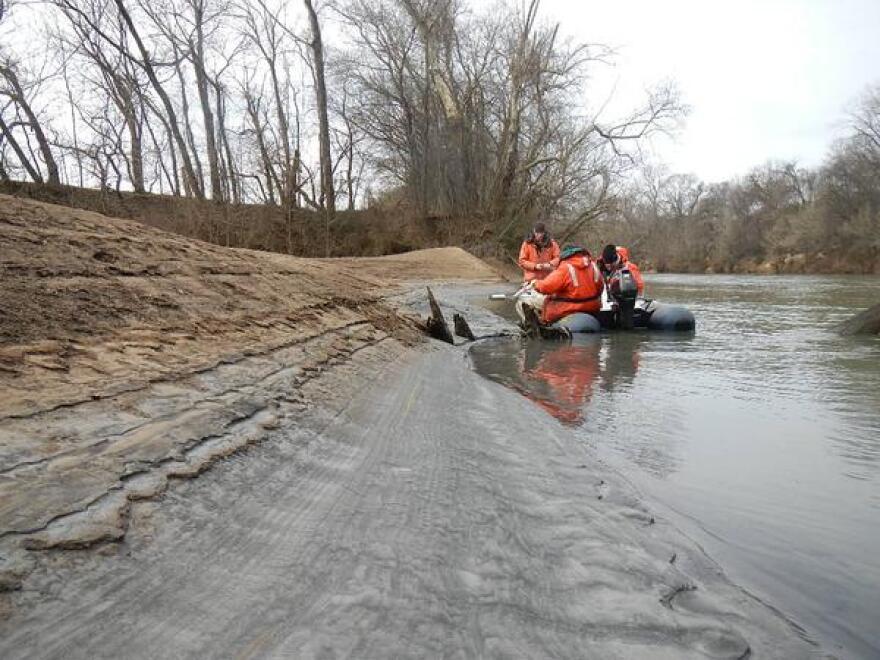Politicians, regulators, engineers, and commissions are trying to decide what to do with the 100-million tons of coal ash in 32 pits and ponds across North Carolina.
Before a broken storm pipe caused 33,000 tons of coal ash to spill into the Dan River back in February, most people had never heard of it.
So what is coal ash? How dangerous is it? And what are we going to do with it?
Question #1: What is coal ash?
When coal arrives at a power plant, it’s pulverized and burned in a boiler.
“The residue that’s left over, everything that’s left when the carbon is burned away, is a mineral powder and that’s the coal ash,” explains Dennis Lemly who has been researching coal ash for more than 30 years at both Wake Forest University and for the U.S. Fish and Wildlife Service.
“Coal ash contains selenium and arsenic and then a variety of heavy metals like mercury and cadmium and lead and chromium, copper, nickel and zinc.”
Many of those trace elements and heavy metals are naturally occurring. But in coal ash, they are concentrated.
Question #2: How dangerous is coal ash?
Coal ash leaks have occurred since the first pit was dug, and a few have resulted in massive fish kills.
“Coal ash is much like ash from your charcoal grill or your wood fireplace,” Richard Baker, Duke Energy’s director of water and natural resources, told the Coal Ash Management Commission last month.
That may be true in how it looks, but that’s where the comparison ends.
“The charcoal in your grill is not true coal,” says Lemly. “It’s actually a burnt wood product. It’s a similar substance to coal, but it’s not nearly as dense and it doesn’t have nearly as high a concentration of these trace elements or heavy metals.”
Concentration is one of the two factors into how dangerous coal ash can be. The other is length of exposure.
How long something or someone may be exposed to coal ash is a question of proximity. Because coal plants need a lot of water, they are built near waterways. That means coal ash pits are also near waterways.
Fish, of course, live in waterways. Coal ash leaks have occurred since the first pit was dug, and a few have resulted in massive fish kills. Two of the worst in North Carolina happened in the 1970s and 1980s when selenium seeped into Belews Lake and Hyco Reservoir.
People have also made claims that coal ash caused their health problems.
Kim Brewer lived in Dukeville, a community built to house employees at Duke Energy’s now closed Buck Steam Station in Rowan County.
Brewer blames coal ash for a variety of issues that affected her daughters, including spina bifida, brain defects, epilepsy, and severe asthma.
“Throughout both pregnancies and when the girls were little, we drank, bathed in, and cooked with the water from our family’s well in Dukeville,” says Brewer.
No scientific study has been found to directly link coal ash to cancer or other health problems. But water studies at Dukeville and other locations across the state have shown elevated levels of selenium, chromium and other elements, above state standards.
Question #3: What should be done with coal ash?
'At the very worst, they may start to leak over time, so that we have all these cells of buried coal ash leaking into the groundwater that will become a larger and larger issue over the next millennium.'
That brings us to question number three: What to do with it. The EPA’s pending decision on whether to classify coal ash as a hazardous waste will play a role in the answer.
Coal has been the key component to a century’s worth of cheap electricity. Some say that bill is coming due now. Taking coal ash to lined and capped landfills will likely take decades and cost tens of billions of dollars.
“At the very best, they may work,” Lemly says of the landfills. “At the very worst, they may start to leak over time, so that we have all these cells of buried coal ash leaking into the groundwater that will become a larger and larger issue over the next millennium.”










